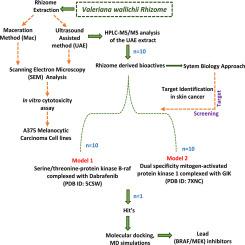利用高效液相色谱-质谱联用技术对黑素细胞癌中B-raf/MEK信号通路进行表征
Pharmacological Research - Modern Chinese Medicine
Pub Date : 2025-08-14
DOI:10.1016/j.prmcm.2025.100674
引用次数: 0
摘要
Valeriana wallichii (mjilù róng cǎo)是一种原产于中国西南部的传统草药,有望成为新型抗癌药物的来源。本研究通过集成的计算机体外药理学方法探索其对A375人黑色素瘤细胞的治疗潜力。高效液相色谱-串联质谱(HPLC-MS/MS)分析了超声辅助水醇提取物的主要植物成分,特别是绿原酸和奎宁酸。网络药理学分析将这些代谢物与参与皮肤癌进展的关键信号通路联系起来,特别是MAPK、PI3K-Akt和Ras通路。靶标预测和蛋白质相互作用网络进一步揭示了BRAF和MEK等关键节点的调节。分子对接显示,绿原酸在BRAF (CYS532、ASP594、LYS483、GLY534)和MEK (SER150、ALA95)的atp结合域具有很强的结合亲和力,其相互作用能与参比抑制剂dabrafenib和DS03090629相当。分子动力学模拟(100 ns)证实绿原酸稳定占据这些活性位点,支持其作为BRAF/MEK双抑制剂的潜力。ADME预测显示主要化合物具有良好的药物样性质。对A375黑色素瘤细胞的体外细胞毒性试验表明,通过超声波获得的V. wallichii提取物(IC₅₀= 172.8±1.07 μg/mL)具有显着的抗增殖作用,扫描电镜显示细胞膜破坏增强,可能是由于生物活性提取效率的提高。总的来说,这些发现强调了缬草根茎代谢物,特别是绿原酸作为黑色素细胞癌多靶点治疗药物的潜力。本研究为华里草的传统中药应用提供了科学验证,为其作为靶向BRAF/MEK信号通路的现代药物干预皮肤癌的研究奠定了基础。本文章由计算机程序翻译,如有差异,请以英文原文为准。

Targeting B-raf/MEK signaling in melanocytic carcinoma using HPLC-MS/MS characterized metabolites from Valeriana wallichii Rhizome
Valeriana wallichii (mǎ lù róng cǎo), a traditional medicinal herb native to southwestern China, holds promise as a source of novel anticancer agents. This study explores its therapeutic potential against A375 human melanoma cells through an integrated in silico, in vitro pharmacological approach. High-performance liquid chromatography tandem mass spectrometry (HPLC-MS/MS) profiling of the ultrasonication-assisted hydroalcoholic extract identified key phytoconstituents, notably chlorogenic acid and quinic acid. Network pharmacology analysis linked these metabolites to critical signaling pathways involved in skin cancer progression, particularly the MAPK, PI3K-Akt, and Ras pathways. Target prediction and protein interaction networks further revealed modulation of key nodes such as BRAF and MEK. Molecular docking highlighted strong binding affinities of chlorogenic acid at the ATP-binding domains of both BRAF (CYS532, ASP594, LYS483, GLY534) and MEK (SER150, ALA95), with interaction energies comparable to reference inhibitors dabrafenib and DS03090629. Molecular dynamics simulations (100 ns) confirmed the stable occupation of these active sites by chlorogenic acid, supporting its potential as a dual BRAF/MEK inhibitor. ADME predictions revealed favorable drug-like properties for the major compounds. In vitro cytotoxicity assays on A375 melanoma cells demonstrated significant antiproliferative effects of the V. wallichii extract obtained via ultrasonication (IC₅₀ = 172.8 ± 1.07 μg/mL), with scanning electron microscopy indicating enhanced cell membrane disruption, likely due to improved bioactive extraction efficiency. Collectively, these findings underscore the potential of Valeriana wallichii rhizome metabolites, particularly chlorogenic acid, as multitargeted therapeutic agents in melanocytic carcinoma. This study provides scientific validation for the traditional use of V. wallichii in Chinese medicine and lays the groundwork for its development as a modern pharmacological intervention targeting BRAF/MEK signaling in skin cancer.
求助全文
通过发布文献求助,成功后即可免费获取论文全文。
去求助

 求助内容:
求助内容: 应助结果提醒方式:
应助结果提醒方式:


